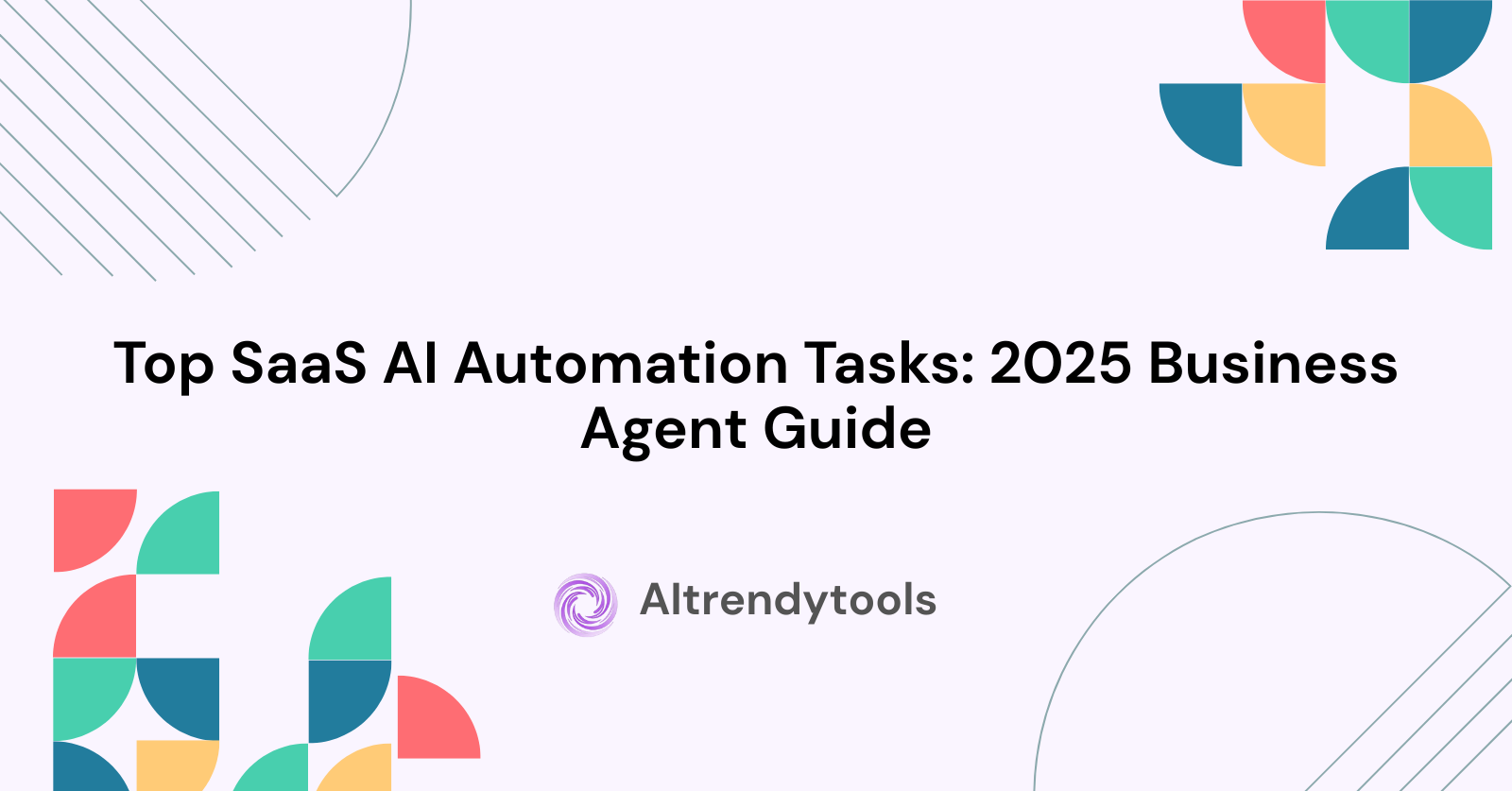🔥 AITrendytools: The Fastest-Growing AI Platform |
Write for usTop SaaS AI Automation Tasks: 2025 Business Agent Guide
Discover which business tasks SaaS teams automate with AI agents. Learn customer support, sales, marketing automation strategies for growth.
Sep 17, 2025
SaaS AI Agent Automation Revolution
SaaS teams worldwide are experiencing a fundamental shift in how they handle routine business operations. AI agents have moved beyond experimental tools to become essential components of modern business infrastructure. These intelligent systems now handle complex tasks that previously required significant human intervention and time investment.
The adoption of AI agents in SaaS environments has accelerated dramatically over the past year. Companies report productivity improvements of 40-60% in automated departments while maintaining or improving service quality. This transformation affects every business function from customer support to financial reporting.
Leading SaaS organizations leverage AI agents to solve scalability challenges without proportional increases in headcount. Small teams can now deliver enterprise-level service quality through intelligent automation. The strategic advantage comes from reallocating human resources to high-value activities while AI handles repetitive operations.
The most successful implementations focus on specific, well-defined tasks rather than attempting to automate entire workflows immediately. This targeted approach allows teams to measure results, refine processes, and build confidence in AI capabilities before expanding automation scope.
Customer Support AI Agent Tasks
Customer support represents one of the most mature areas for AI agent implementation in SaaS companies. Teams have successfully automated various support functions while maintaining personalized customer experiences that drive satisfaction and retention.
Automated Ticket Classification and Routing
AI agents now handle the initial processing of customer support requests with remarkable accuracy. These systems analyze incoming tickets, categorize issues by type and urgency, and route them to appropriate team members or departments.
The classification process considers multiple factors including:
- Customer tier and subscription level
- Issue complexity and technical requirements
- Historical resolution patterns for similar problems
- Agent expertise areas and current workload
- Time zones and language preferences
This intelligent routing eliminates manual triage work and ensures customers reach the right support specialist immediately. Response times improve significantly while reducing the likelihood of escalations due to misrouted tickets.
Real-Time Response Generation
Advanced AI agents provide instant responses to common customer inquiries while maintaining brand voice consistency. These systems access knowledge bases, product documentation, and historical resolution data to generate accurate, helpful responses.
The AI can handle routine questions about account settings, billing inquiries, feature explanations, and basic troubleshooting. When encounters with complex issues arise, the system seamlessly escalates to human agents while providing complete context about the customer interaction.
Sentiment Analysis and Escalation Management
AI agents continuously monitor customer communication tone and satisfaction indicators. The system identifies frustrated customers before situations escalate and automatically prioritizes their cases for immediate human attention.
Sentiment analysis extends beyond individual interactions to track customer satisfaction trends over time. Teams receive alerts about declining satisfaction scores and can proactively address issues before they impact retention rates.
Sales Process AI Automation
Sales teams leverage AI agents to streamline prospecting, lead qualification, and deal management processes. These automated systems handle time-consuming research and administrative tasks while enabling sales professionals to focus on relationship building and closing deals.
Lead Scoring and Qualification
AI agents analyze prospect behavior, company data, and engagement patterns to generate accurate lead scores. The system considers website interactions, content downloads, email engagement, and demographic information to predict conversion likelihood.
Qualification automation includes:
- Company size and budget assessment
- Decision-maker identification and contact mapping
- Competitive landscape analysis and positioning
- Timeline estimation based on buying signal strength
- Integration requirements and technical fit evaluation
This automated qualification ensures sales teams prioritize high-value prospects while nurturing lower-priority leads through targeted campaigns.
Automated Follow-Up Sequences
AI agents manage complex follow-up sequences that adapt based on prospect responses and behavior changes. These systems send personalized messages at optimal times while tracking engagement metrics to refine future communications.
The automation includes calendar scheduling, meeting reminders, and post-meeting follow-ups. AI agents can coordinate between multiple stakeholders and automatically reschedule meetings when conflicts arise.
Deal Pipeline Management
Advanced AI systems monitor deal progression and identify potential roadblocks before they impact closing rates. The agents analyze historical deal patterns, competitor activities, and customer communication to predict outcomes and suggest interventions.
Pipeline automation helps sales managers allocate resources effectively and provides early warning systems for deals at risk. The AI generates recommendations for advancing stalled opportunities and identifies cross-sell or upsell possibilities.
Marketing Automation AI Agents
Marketing teams deploy AI agents across content creation, campaign management, and performance optimization activities. These systems enable smaller marketing teams to execute sophisticated campaigns while delivering personalized experiences at scale.
Content Generation and Optimization
AI agents create various marketing materials including blog posts, email campaigns, social media content, and ad copy. The systems maintain brand voice consistency while adapting content for different channels and audience segments.
Content optimization includes:
- SEO keyword research and integration
- A/B testing headline and copy variations
- Social media posting schedule optimization
- Email subject line and send time optimization
- Landing page conversion rate improvement
Marketing teams report significant time savings while maintaining content quality and consistency across all channels.
Campaign Performance Monitoring
AI agents continuously monitor campaign performance across multiple channels and automatically adjust targeting, budgets, and messaging based on real-time results. The system identifies underperforming campaigns and reallocates resources to high-converting activities.
Performance monitoring extends to competitive analysis, market trend identification, and seasonal adjustment recommendations. Teams receive actionable insights about campaign optimization opportunities without manual data analysis.
Lead Nurturing Automation
Sophisticated AI agents manage complex lead nurturing sequences that adapt based on prospect behavior and engagement levels. The system personalizes content recommendations, adjusts communication frequency, and identifies optimal conversion moments.
Nurturing automation includes progressive profiling that gradually collects prospect information through strategic content offers. The AI determines which information gaps to address and presents relevant content opportunities accordingly.
Data Analysis and Reporting AI
Data analysis represents a critical area where AI agents deliver significant value for SaaS teams. These systems process large datasets, identify trends, and generate actionable insights that inform strategic decision-making across all business functions.
Automated Dashboard Creation
AI agents generate customized dashboards for different stakeholders automatically pulling data from various sources and presenting relevant metrics in accessible formats. The system updates dashboards in real-time and highlights significant changes or anomalies.
Dashboard automation includes:
- KPI trend analysis and forecasting
- Comparative performance across time periods
- Drill-down capabilities for detailed investigation
- Alert systems for metric threshold breaches
- Export functionality for executive reporting
Teams save hours of manual report preparation while ensuring stakeholders access current, accurate information consistently.
Predictive Analytics and Forecasting
Advanced AI agents analyze historical data patterns to generate accurate forecasts for revenue, churn, resource requirements, and market opportunities. These predictions help teams make informed strategic decisions and allocate resources effectively.
Predictive models consider multiple variables including seasonal patterns, market conditions, competitive activities, and internal performance metrics. The AI continuously refines predictions based on new data and actual outcomes.
Anomaly Detection and Risk Assessment
AI agents monitor business metrics continuously and identify unusual patterns that might indicate problems or opportunities. The system flags anomalies for human investigation while providing context about potential causes and recommended actions.
Risk assessment includes financial performance monitoring, customer health scoring, and operational efficiency tracking. Teams receive early warning systems that enable proactive problem resolution before issues impact business results.
Product Development AI Automation
Product teams leverage AI agents to streamline development processes, user feedback analysis, and feature prioritization. These systems help teams make data-driven product decisions while reducing development cycles and improving user satisfaction.
User Feedback Analysis
AI agents process customer feedback from multiple sources including support tickets, surveys, reviews, and user interviews. The system identifies common themes, feature requests, and pain points while tracking sentiment trends over time.
Feedback analysis includes:
- Feature request prioritization based on user impact
- Bug report categorization and severity assessment
- User experience improvement recommendations
- Competitive feature gap identification
- Customer success story extraction for marketing use
Product managers receive synthesized insights that inform roadmap decisions without spending hours manually reviewing feedback.
Automated Testing and Quality Assurance
AI agents conduct continuous testing of product features, identifying bugs, performance issues, and user experience problems. The system generates detailed reports about issues found and suggests prioritization based on user impact severity.
Testing automation extends to security vulnerability scanning, performance optimization recommendations, and compatibility testing across different platforms and devices. Development teams can focus on building features while AI ensures quality standards.
Feature Usage Analytics
Advanced AI systems track feature adoption rates, user engagement patterns, and success metrics to identify which product elements drive value. The analysis helps teams understand user behavior and optimize product design accordingly.
Usage analytics provide insights about feature abandonment, user workflow optimization opportunities, and areas where additional user education might improve adoption rates.
Financial Operations AI Agents
Finance teams increasingly rely on AI agents for accounting processes, financial reporting, and strategic analysis. These systems improve accuracy while reducing the time required for routine financial operations.
Automated Invoice Processing
AI agents handle invoice data extraction, validation, and processing with high accuracy rates. The system matches invoices to purchase orders, identifies discrepancies, and routes items for approval through appropriate workflows.
Invoice automation includes:
- Vendor payment scheduling and processing
- Tax calculation and compliance verification
- Expense categorization for financial reporting
- Budget tracking and variance analysis
- Audit trail maintenance for compliance purposes
Finance teams eliminate manual data entry while improving payment accuracy and vendor relationship management.
Financial Reporting Automation
AI agents generate comprehensive financial reports automatically pulling data from various sources and ensuring accuracy through validation checks. The system creates monthly, quarterly, and annual reports while highlighting significant changes or trends.
Reporting automation includes cash flow forecasting, profitability analysis by customer segment, and cost center performance tracking. Executives receive timely, accurate financial information without manual preparation delays.
Expense Management and Compliance
Advanced AI systems monitor expense submissions, verify compliance with company policies, and identify potential fraud or policy violations. The agents process expense reports quickly while maintaining audit trails for compliance purposes.
Expense management includes travel booking optimization, vendor payment automation, and budget allocation tracking. Teams maintain financial control while reducing administrative overhead.
HR and Recruitment AI Automation
Human resources teams deploy AI agents across recruitment, employee onboarding, and performance management processes. These systems improve candidate experience while reducing time-to-hire and administrative burden on HR professionals.
Resume Screening and Candidate Matching
AI agents analyze resumes, cover letters, and application materials to identify qualified candidates for open positions. The system matches candidate skills and experience to job requirements while eliminating unconscious bias from initial screening processes.
Candidate matching includes:
- Skills assessment based on resume content and online profiles
- Cultural fit evaluation using communication style analysis
- Salary expectation alignment with position budgets
- Availability and timeline compatibility assessment
- Reference check scheduling and initial outreach
Recruiting teams focus on interviewing qualified candidates while AI handles initial screening and administrative tasks.
Employee Onboarding Automation
AI agents manage new employee onboarding processes including document collection, system access provisioning, and training schedule coordination. The system ensures consistent experiences while tracking completion rates and identifying process improvements.
Onboarding automation includes welcome message personalization, mentor assignment based on role and experience, and progress tracking through required training modules. New employees receive support while HR teams monitor onboarding effectiveness.
Performance Review and Feedback Analysis
Advanced AI systems analyze performance review data, identify trends in employee satisfaction and growth areas, and generate insights about team performance patterns. The analysis helps managers provide better support and development opportunities.
Performance analysis includes skill gap identification, career development recommendations, and retention risk assessment. HR teams can proactively address employee concerns while supporting professional growth objectives.
Implementation Best Practices for SaaS AI Agents
Successful AI agent implementation requires strategic planning, careful process design, and ongoing optimization. Teams that follow proven best practices achieve better results while avoiding common implementation pitfalls.
Start with High-Impact, Low-Risk Tasks
Begin AI agent implementation with routine, well-defined tasks that have clear success metrics. Customer support ticket routing, basic data entry, and simple email responses provide excellent starting points for automation.
High-impact automation targets include:
- Repetitive manual processes consuming significant time
- Tasks prone to human error or inconsistency
- Operations requiring 24/7 availability
- Processes with clear decision criteria and outcomes
- Activities that don't require complex judgment or creativity
This approach builds confidence in AI capabilities while delivering immediate value to justify additional automation investments.
Establish Clear Success Metrics
Define specific, measurable goals for each AI agent implementation including efficiency improvements, error reduction, cost savings, and customer satisfaction impacts. Regular monitoring ensures automation delivers expected value.
Success measurement should include both quantitative metrics like processing time and qualitative factors such as user satisfaction and system reliability. Teams need comprehensive data to optimize AI performance continuously.
Maintain Human Oversight and Escalation Paths
Design AI agent workflows with clear escalation procedures for complex situations requiring human judgment. The system should recognize its limitations and seamlessly transfer control to human team members when appropriate.
Human oversight includes quality assurance checks, performance monitoring, and regular system training updates. Teams must balance automation efficiency with the flexibility to handle edge cases and unique situations.
Continuous Training and Optimization
AI agents require ongoing training with new data, feedback incorporation, and performance optimization. Teams should establish regular review cycles to assess automation effectiveness and identify improvement opportunities. Resources like AiTrendyTools offer valuable insights into emerging AI automation trends and tool comparisons that help teams optimize their automation strategies.
Training optimization includes user feedback integration, process refinement based on actual usage patterns, and system updates to handle new scenarios. Successful automation evolves continuously rather than remaining static after initial implementation.
ROI and Performance Metrics
Measuring AI agent performance requires comprehensive tracking of efficiency gains, cost savings, quality improvements, and user satisfaction changes. Organizations need clear metrics to justify automation investments and guide future expansion decisions.
Productivity and Efficiency Gains
Track time savings, task completion rates, and throughput improvements across automated processes. Compare pre-automation baseline metrics with current performance to quantify productivity benefits.
Efficiency measurement includes:
- Processing time reduction for routine tasks
- Error rate improvements in automated processes
- Capacity increases without additional headcount
- Response time improvements for customer-facing operations
- Resource allocation optimization across different activities
These metrics demonstrate the direct operational impact of AI agent implementation.
Cost Reduction Analysis
Calculate total cost savings including reduced labor costs, improved accuracy reducing rework, and efficiency gains enabling revenue growth without proportional expense increases.
Cost analysis should include implementation expenses, ongoing maintenance costs, and training requirements to provide accurate ROI calculations. Teams need comprehensive cost understanding to make informed automation expansion decisions.
Quality and Satisfaction Improvements
Monitor customer satisfaction scores, employee feedback, and process quality metrics to ensure automation enhances rather than compromises service delivery.
Quality metrics include customer response times, issue resolution rates, employee satisfaction with automated tools, and overall service quality consistency. Successful automation improves both efficiency and experience quality.
Frequently Asked Questions
What types of SaaS tasks are best suited for AI agent automation?
Repetitive, rule-based tasks with clear decision criteria work best for AI automation. Customer support routing, data entry, basic analysis, and routine communications offer excellent automation opportunities with measurable benefits.
How long does it typically take to implement AI agents for business tasks? Implementation timelines vary from 2-4 weeks for simple tasks like email automation to 3-6 months for complex workflows involving multiple systems. Most teams see initial benefits within the first month of deployment.
What are the main challenges SaaS teams face when implementing AI agents? Common challenges include data quality issues, integration complexity with existing systems, staff training requirements, and establishing appropriate human oversight processes. Proper planning addresses most implementation obstacles.
How do AI agents handle exceptions and edge cases?
Well-designed AI agents include escalation protocols that transfer complex situations to human team members. The system recognizes its limitations and provides complete context to human agents for seamless handoffs.
What ROI can SaaS teams expect from AI agent automation?
Most teams report 40-60% productivity improvements in automated areas within six months. Cost savings typically range from 20-40% for targeted processes, with additional benefits from improved accuracy and faster response times.
How do AI agents integrate with existing SaaS tools and workflows?
Modern AI agents connect through APIs and integration platforms to work with existing business systems. The automation layer operates alongside current tools rather than requiring complete system replacements.
Conclusion
AI agents have become indispensable tools for SaaS teams seeking to scale operations efficiently while maintaining service quality. The automation opportunities span every business function from customer support to financial operations, offering significant productivity improvements and cost savings.
The most successful implementations focus on specific, measurable tasks rather than attempting comprehensive automation immediately. Teams that start with high-impact, low-risk processes build confidence and expertise while delivering immediate value to justify additional automation investments.
The future of SaaS operations increasingly depends on intelligent automation that augments human capabilities rather than replacing them entirely. AI agents handle routine, repetitive tasks while freeing human team members to focus on strategic activities, creative problem-solving, and relationship building that drive business growth.
Organizations that embrace AI agent automation now gain competitive advantages through improved efficiency, enhanced customer experiences, and better resource allocation. The technology has matured beyond experimental phases to become essential infrastructure for modern SaaS operations seeking sustainable growth and operational excellence.
🚀 Submit Your Tool to Our Comprehensive AI Tools Directory
Get your AI tool featured on our complete directory at AITrendytools and reach thousands of potential users. Select the plan that best fits your needs.





Join 30,000+ Co-Founders
Related Blogs
Dext Review 2025: Guide to Automate Your Bookkeeping
Discover how Dext software transforms expense management with 99.9% accuracy. Complete guide to features, pricing, integrations & alternatives for 2025.
Texto Invisible: 10 Ways to Copy Hidden Text & Blank Space
Master texto invisible for WhatsApp, Instagram & gaming. Learn how to create hidden text, blank characters & empty spaces. Free generator + step by step guide
WriteHuman AI Review: Does It Really Bypass AI Detectors?
Honest WriteHuman AI review with real testing results. Learn if this AI humanizer actually works, pricing details, and better alternatives for 2025.
Submit Your Tool to Our Comprehensive AI Tools Directory
List your AI tool on AItrendytools and reach a growing audience of AI users and founders. Boost visibility and showcase your innovation in a curated directory of 30,000+ AI apps.





Join 30,000+ Co-Founders

